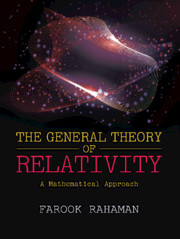Refine listing
Actions for selected content:
17000 results
6 - Interstellar Dust
-
- Book:
- Interstellar and Intergalactic Medium
- Published online:
- 22 September 2021
- Print publication:
- 25 March 2021, pp 130-153
-
- Chapter
- Export citation
1 - Introduction
-
- Book:
- Interstellar and Intergalactic Medium
- Published online:
- 22 September 2021
- Print publication:
- 25 March 2021, pp 1-30
-
- Chapter
- Export citation
Copyright page
-
- Book:
- Interstellar and Intergalactic Medium
- Published online:
- 22 September 2021
- Print publication:
- 25 March 2021, pp iv-iv
-
- Chapter
- Export citation
Constants and Units
-
- Book:
- Interstellar and Intergalactic Medium
- Published online:
- 22 September 2021
- Print publication:
- 25 March 2021, pp 243-244
-
- Chapter
- Export citation
Contents
-
- Book:
- Interstellar and Intergalactic Medium
- Published online:
- 22 September 2021
- Print publication:
- 25 March 2021, pp vii-x
-
- Chapter
- Export citation
2 - Cold Neutral Medium
-
- Book:
- Interstellar and Intergalactic Medium
- Published online:
- 22 September 2021
- Print publication:
- 25 March 2021, pp 31-53
-
- Chapter
- Export citation
4 - Warm Ionized Medium and Ionized Nebulae
-
- Book:
- Interstellar and Intergalactic Medium
- Published online:
- 22 September 2021
- Print publication:
- 25 March 2021, pp 70-105
-
- Chapter
- Export citation
Preface
-
- Book:
- Interstellar and Intergalactic Medium
- Published online:
- 22 September 2021
- Print publication:
- 25 March 2021, pp xi-xii
-
- Chapter
- Export citation
3 - Warm Neutral Medium
-
- Book:
- Interstellar and Intergalactic Medium
- Published online:
- 22 September 2021
- Print publication:
- 25 March 2021, pp 54-69
-
- Chapter
- Export citation
Dedication
-
- Book:
- Interstellar and Intergalactic Medium
- Published online:
- 22 September 2021
- Print publication:
- 25 March 2021, pp v-vi
-
- Chapter
- Export citation
Index
-
- Book:
- Interstellar and Intergalactic Medium
- Published online:
- 22 September 2021
- Print publication:
- 25 March 2021, pp 245-248
-
- Chapter
- Export citation
8 - Circumgalactic and Intracluster Gas
-
- Book:
- Interstellar and Intergalactic Medium
- Published online:
- 22 September 2021
- Print publication:
- 25 March 2021, pp 181-197
-
- Chapter
- Export citation
5 - Hot Ionized Medium
-
- Book:
- Interstellar and Intergalactic Medium
- Published online:
- 22 September 2021
- Print publication:
- 25 March 2021, pp 106-129
-
- Chapter
- Export citation
10 - Warm-Hot Intergalactic Medium
-
- Book:
- Interstellar and Intergalactic Medium
- Published online:
- 22 September 2021
- Print publication:
- 25 March 2021, pp 220-230
-
- Chapter
- Export citation
Bibliography, References, and Figure Credits
-
- Book:
- Interstellar and Intergalactic Medium
- Published online:
- 22 September 2021
- Print publication:
- 25 March 2021, pp 231-242
-
- Chapter
- Export citation
9 - Diffuse Intergalactic Medium
-
- Book:
- Interstellar and Intergalactic Medium
- Published online:
- 22 September 2021
- Print publication:
- 25 March 2021, pp 198-219
-
- Chapter
- Export citation
7 - Molecular Clouds
-
- Book:
- Interstellar and Intergalactic Medium
- Published online:
- 22 September 2021
- Print publication:
- 25 March 2021, pp 154-180
-
- Chapter
- Export citation

The General Theory of Relativity
- A Mathematical Approach
-
- Published online:
- 24 March 2021
- Print publication:
- 05 August 2021
7 - Molecular Regions
-
- Book:
- Introduction to the Interstellar Medium
- Published online:
- 28 January 2021
- Print publication:
- 18 February 2021, pp 88-110
-
- Chapter
- Export citation
10 - The ISM on the Galactic Scale
-
- Book:
- Introduction to the Interstellar Medium
- Published online:
- 28 January 2021
- Print publication:
- 18 February 2021, pp 163-176
-
- Chapter
- Export citation
